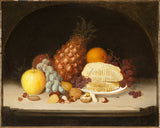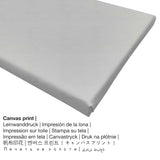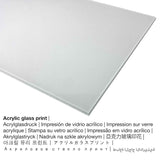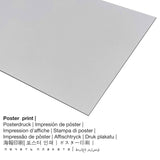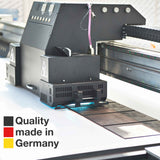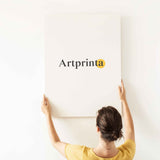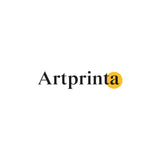Robert S. Duncanson, 1849 - Still Life - ọmarịcha nka
Ụtụ gụnyere. Mbupu gbakọrọ na ndenye ọpụpụ.
Kedu ihe ngwaahịa kacha amasị gị?
In the product dropdown menu you can select your favorite material and size. The following options are available for individualization:
- Mbipụta iko acrylic (nke nwere ezigbo mkpuchi iko): A glossy print on acrylic glass, which is sometimes labelled as a an art print on plexiglass, will change your favorite original artwork into great décor. Your artwork is being custom-made thanks to the help of modern UV print machines.
- Poster (akwa akwa akwa): The poster is a printed sheet of canvas paper with a slight structure on the surface, which resembles the actual artwork. A printed poster is used for placing your art copy using a custom frame. Please bear in mind, that depending on the absolute size of the poster print we add a white margin between 2-6 cm round about the painting, which facilitates the framing with your custom frame.
- Mbipụta kwaaji: The canvas direct print is a printed cotton canvas mounted on a wooden frame. A canvas has a typical impression of three-dimensionality. The canvas print creates a charming and comfy atmosphere. Canvas prints are relatively low in weight, which implies that it is easy to hang up your Canvas print without the use of additional wall-mounts. A canvas print is suited for any type of wall.
- Mbipụta ọla (aluminium dibbond): These are metal prints on aluminium dibond with an impressive depth. For the Direct Aluminium Dibond option, we print your selected artpiece right onto the surface of the aluminum material.
Ihe dị mkpa: We try to describe our art products as precisely as possible and to demonstrate them visually. Nonetheless, the colors of the print products, as well as the print result can diverge slightly from the presentation on the screen. Depending on the screen settings and the quality of the surface, not all color pigments will be printed as exactly as the digital version on this website. Since all art reproductions are printed and processed manually, there might as well be minor discrepancies in the exact position and the size of the motif.
Ozi izizi gbasara nka nke Los Angeles County Museum of Art (© - site na Los Angeles County Museum of Art - www.lacma.org)
Still-life paintings are rare in Duncanson’s oeuvre. Seven canvases are known today. The decorations Duncanson created from 1848 to 1850 for Belmont, the home of his patron Nicholas Longworth (now the Taft Museum, Cincinnati), may have stimulated his interest in such subject matter. Although painted in a different, more rococo style, the decorative panels included two overdoor designs of fruit and flowers in vases. Longworth was not only a lawyer and a major patron of the arts but one of the finest horticulturists in America. He played a major role in the commercialization of grapes and cultivation of strawberries. However, in none of Duncanson’s located still, lifes did the artist focus on grapes. Rather, in the fashion of most still-life specialists, he included a variety of food: apples, grapes, oranges, raisins, nuts, pineapples, and honeycombs. The last two items were considered exotic and often were included in Victorian still lifes; in the South the pineapple was a symbol of hospitality. Still Life is a transitional piece, exhibiting characteristics typical of both early- and midnineteenth-century American still-life paintings, due in part to the date of the painting and to the fact that it was painted in a frontier environment, which slightly lagged behind the East in artistic developments. In the tradition of paintings by the Peale family, the fruit and nuts are arranged on a bare, wood table with a dark background and strong lighting. Duncanson’s composition is more elaborate than the spare, neoclassical arrangements of Raphaelle Peale (1774-1825) and closer to those by James Peale (1749-1831) and younger Peale children. In fact, Sarah Miriam Peale (1800-1885) extended the Peale influence to the West when she moved to Saint Louis in 1847. The arched format was a later, more Victorian element, however, used by SEVERIN ROESEN and many other artists of the 1850s and 1860s. Two other Duncanson still-life paintings (Detroit Institute of Arts and Corcoran Gallery of Art, Washington, D.C.) have similar compositional treatments and formats. However, in these two, following mid-century fashion, the still-life elements are set on a white tablecloth rather than a bare wooden table. In complexity of arrangement, the museum’s still life seems to be midway between the Corcoran Gallery picture, the least complex, and that in the Detroit Institute, the most complex. Duncanson exhibited his fruit still-life paintings at state fairs and art displays in Detroit, Cincinnati, and New York during the late 1840s and 1850s. While not all the exhibits can be definitely identified with known works, it is probable that the museum’s still life was shown at one time, possibly at the Western Art Union or Detroit Gallery of Fine Arts in Fireman’s Hall.
In 1849 onye America ese Robert S. Duncanson kee ihe 19th narị afọ artpiece. The more than 170 years old original creation was painted with the size 16 1/4 x 20 3/16 in (41 x 51,28 cm) and was manufactured with the medium oil on canvas. Besides, this artpiece is in the the art collection of Los Angeles County Museum of Art, which is located in Los Angeles, California, United States of America. With courtesy of: Los Angeles County Museum of Art (www.lacma.org) (ọha na eze).: . Ihe ọzọ bụ, itinye n'ọnọdụ nke dijitalụ mmeputakwa bụ na odida obodo format na a akụkụ ruru nke 1.2: 1, nke pụtara na ogologo bụ 20% ogologo karịa obosara.
Nkọwa na ọrụ nka pụrụ iche
| Aha nke ọrụ nka: | "Ndụ ka dị" |
| Nhazi nka: | sere |
| Okwu mkpokọta: | nkà nke oge a |
| oge: | 19th narị afọ |
| Afọ nka: | 1849 |
| Afọ nka: | karịa afọ 170 |
| Ihe osise izizi: | mmanụ na kwaaji |
| Akụkụ nke ọrụ nka mbụ: | 16 1/4 x 20 3/16 na (41 x 51,28 cm) |
| Ụlọ ihe ngosi nka / ebe: | Ebe ngosi nka nke Los Angeles County |
| Ebe ngosi nka: | Los Angeles, California, Njikota Obodo Amerika |
| Ibe weebụ: | Ebe ngosi nka nke Los Angeles County |
| Ụdị ikike nka: | ngalaba ọha |
| Site n'aka: | Ụlọ ihe ngosi nka nke Los Angeles County (www.lacma.org) |
Ngwaahịa a
| Nkewa edemede: | ezi nka mmeputakwa |
| Usoro mmeputakwa: | dijitalụ mmeputakwa |
| Production usoro: | Mbipụta UV / dijitalụ |
| Nlụpụta: | German mmepụta |
| Ụdị ngwaahịa: | na mmepụta ihe |
| Ihe eji eme atụmatụ: | ihe ndozi ụlọ, nka mgbidi |
| Ndepụta: | nhazi odida obodo |
| Oke akụkụ: | ogologo ruo obosara 1.2: 1 |
| Mmetụta akụkụ: | ogologo bụ 20% ogologo karịa obosara |
| Nhọrọ dị: | Mpempe akwụkwọ, akwụkwọ mmado (akwụkwọ kwaaji), mbipụta ọla (aluminium dibond), mbipụta iko acrylic (nwere ezigbo mkpuchi iko) |
| Nhọrọ nha nke akwa akwa n'elu etiti ihe na-agbatị (mbipụta kwaaji): | 60x50cm - 24x20", 120x100cm - 47x39" |
| Mpempe iko acrylic (nwere ezigbo mkpuchi iko) nha: | 60x50cm - 24x20", 120x100cm - 47x39" |
| Nhọrọ nha nke akwụkwọ mmado (akwụkwọ kwaaji): | 60x50cm - 24x20", 120x100cm - 47x39" |
| Mbipụta aluminom (ihe alumini debond ihe): | 60x50cm - 24x20", 120x100cm - 47x39" |
| Igwe onyonyo: | adịghị |
Ozi izugbe gbasara onye na-ese ihe
| Aha onye nka: | Robert S. Duncanson |
| okike onye nka: | nwoke |
| Nationality: | American |
| Ọrụ onye na-ese ihe: | onye na-ese ihe |
| Obodo obibi: | United States |
| Nhazi nke onye nka: | omenkà nke oge a |
| Nwụrụ anwụ: | 51 afọ |
| Afọ amụrụ: | 1821 |
| Afọ nwụrụ: | 1872 |
© Nwebiisinka - ikike ọgụgụ isi nke - Artprinta.com

